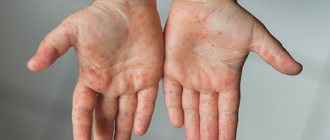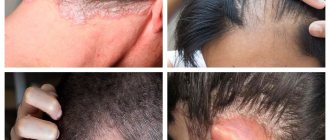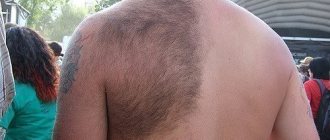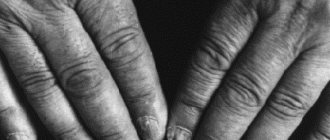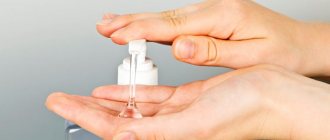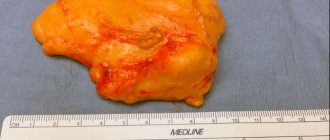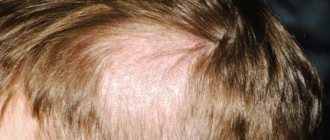Causes of the disease
The causes of urticaria in children are:
- sensitivity to allergens;
- consumption of allergens in food, their inhalation;
- taking certain medications;
- bites of some insects;
- tactile contact with the allergen (urticaria in a child may appear after sleep due to a reaction to the dye in the bedding fabric or washing powder). Source: L.V. Luss Causes and treatment of urticaria in children, swelling in children // Medical Council, 2015, No. 14
Upon contact with an allergen, inflammation occurs, fluid accumulates in the body tissues, and a rash and swelling appear. This reaction of the body is an attempt to reduce the amount of harmful substances.
Chronic urticaria, which can appear as early as one year of age, occurs due to:
- chronic or long-term gastrointestinal diseases;
- chronic inflammation;
- viral infections;
- parasite infestation;
- fungal diseases;
- disturbances in the functioning of the nervous system;
- hereditary predisposition.
The disease can be provoked by overheating or hypothermia of the skin, exposure to UV or water, when combing or injury by elements of clothing, due to severe stress. With such urticaria (it is called “cholinergic”), children do not have an elevated body temperature, and external manifestations quickly disappear (in a few minutes, maximum half an hour). Source: I.I. Balabolkin. Urticaria in children: clinical and pathogenetic variants, diagnosis and treatment // Russian Pediatric Journal, 2022, 20(2)
Causes of urticaria
As soon as the hypothalamus registers an increase in body temperature in the brain, it sends an impulse to neurons that activate the sweat glands. Neurons release acetylcholine, which stimulates the release of histamine and heparin from mast cells in the skin (mast cell degranulation). This degranulation results in a diffuse release of histamine near the sweat glands. Histamine activates an inflammatory response in surrounding tissues and causes itching and redness. When you sweat (which is difficult for people with cholinergic urticaria), the skin reaction stops.
Chronic stress and nervousness can trigger an attack of psychosomatic urticaria. When constantly anxious, the body releases higher amounts of cortisol and adrenaline (stress hormones). But when the body is constantly in a state of tension and hormones continue to be released into the bloodstream, hormonal imbalance occurs. Adrenaline and cortisol combine with mast cells in the skin to produce histamine. Elevated levels of cortisol in the body cause allergic skin reactions such as hives and may even slow down healing.
Urticaria is usually a consequence of an allergic reaction in children when the body is exposed to the following allergens:
- pollen of flowering plants;
- house dust (dust mites);
- pet hair;
- some preservatives;
- Food.
Hives can also occur when a child wears clothes that are too tight and made from irritating materials such as polyester. It can also be caused by infections caused by bacteria, viruses or other microorganisms.
Some medications, such as ibuprofen, can cause hives in children as a side effect. Also, such a reaction can occur if the child has an individual intolerance to one or another substance included in the medicine. Most often these are antibacterial and non-steroidal drugs.
If children are suddenly exposed to large temperature fluctuations, hives may result. Likewise, prolonged exposure to the sun or cold can cause a similar skin reaction. In rare cases, urticaria can develop due to diseases such as leukemia and lymphoma. This happens because the immune system is weakened.
Hives in children can also be caused by insect bites, which can lead to significant swelling. If it's a mosquito or spider bite, sensitive skin may respond by releasing histamine, which causes hives. Contact with various viruses or bacteria can cause a diffuse rash. Reddened plaques can be observed throughout the body.
Diagnostic methods
When this disease develops, the patient or his parents are interviewed and the symptoms are analyzed.
The doctor can make a preliminary diagnosis after examining the child’s skin. A rash with urticaria is difficult to confuse with another. However, to exclude errors and establish the cause, tests are prescribed:
- stool analysis, which will help identify parasites - they can be pathogens;
- general blood test - identifies or excludes inflammatory and immune processes;
- allergy tests - skin tests to identify the pathogen;
- liver tests - to determine liver function and exclude its pathologies.
Thyroid function may be tested because the disease can be caused by hypo- or hyperthyroidism.
Types of disease
In medicine, there are five main forms of this disease:
- chronic with periodic exacerbations;
- acute, arising and spreading rapidly;
- allergic (affects 70% of children);
- pseudo-allergic (provoked by disturbances in the functioning of the liver and digestive organs);
- hereditary non-allergic (accompanied by Quincke's edema, similar to allergic). Source: L.P. Sizyakina, A.A. Lebedenko, C.B. Maltsev, A.N. Posevina, L.A. Averkina Urticaria in children: a modern view of the problem // Medical Bulletin of the South of Russia, Reviews, 2015
Let's take a closer look at the types of urticaria, depending on the triggering factor:
- Medicinal. A type of drug allergy is a reaction to certain drugs. The most common provocateurs are iodides, streptomycin, sedatives, NSAIDs, and drugs containing gold. The rash may be accompanied by a runny nose, conjunctivitis and bronchial asthma. To cure this form of urticaria, you need to eliminate the allergen, adjust the diet, removing the brightest allergens from it - citrus fruits, red vegetables and fruits, nuts, cow's milk, fish.
- Mechanical – appears when pressure is applied to the skin. Its causes have not been reliably studied, but the disease is associated with skin sensitivity, heredity and the condition of the blood vessels. Divided into several subspecies:
- dermographic – develops quickly due to friction or pressure, often caused by wearing tight clothing;
- cold - a reaction to contact with something cold, drinks or foods;
- heat – the rash appears when the environment is hot;
- solar - occurs during prolonged exposure to the sun, manifested by swelling and red spots on the skin;
- aquagenic - rare, but very dangerous, appears upon any contact with water;
- papular - the result of an insect bite;
- cholinergic - a rash appears when the child is nervous and sweats a lot.
- Generalized. It differs in that the rash spreads throughout the body, including the mucous membrane of the oropharynx, which makes breathing difficult. Quincke's edema may develop. Such urticaria appears in children with atopic diseases and can be caused by antibiotics and NSAIDs. Rarely are food products allergens.
- Idiopathic. The cause is unknown, but itchy blisters appear regularly over a period of 6 weeks at varying intervals. The process is considered chronic. Spontaneous occurrence and the lack of diagnostic methods make it difficult to control the course of the disease, treatment and prevention.
Folk remedies in the treatment of urticaria
Therapeutic measures with folk recipes are used as additional treatment. If you follow all the recommendations, products made from natural ingredients will improve the general condition of a person and reduce the symptoms of the disease in a child. Effective recipes against urticaria and allergies:
- Infusions
— intended for oral administration, prepared from the roots and bark of plants. In order for the beneficial properties to be better preserved, the medicine should be boiled in a water bath for at least 20 minutes. To prepare the daily dose of the drug you need to take 1 tbsp. l. dried ingredients and 1 glass of water. - Solutions
- made for lotions, have a drying effect. You will need medicinal plants and other antipruritic ingredients (1 tsp salt per 1 glass of decoction; 1 tbsp vinegar per 1 glass of decoction). - Decoctions
- intended for internal use, prepared from inflorescences and leaves. For the daily norm you need 1 tbsp. l. raw materials and a glass of hot water, leave for 30 minutes. - Ointments
- applied to painful areas of the skin where the rash is located. They are made from dried plants and a fat base (butter, melted fat). It should be melted, added raw materials from plants, kept in the oven for 2-3 hours at low temperature.
In order for herbal medicine to have the desired result, the treatment is carried out comprehensively. It is important to supplement medications for internal use with external ones.
Diet for urticaria
Proper nutrition for urticaria is indicated exclusively for all patients, regardless of the form of the disease and its cause. Allowed products for rashes and other symptoms of the disease:
- fermented milk products (kefir, cottage cheese, low-fat yogurt);
- dairy products;
- eggs;
- boiled, baked vegetables (carrots, zucchini); then
- low-fat varieties of fish and meat;
- oatmeal, buckwheat porridge;
- fruits, berries;
- cereals (oats, millet).
You should drink at least 2 liters of water daily. Prohibited foods for urticaria, which often lead to an allergic reaction:
- fruits (red apples, citruses, peaches);
- nuts (peanuts, almonds);
- yeast bread, buns;
- chocolate, honey;
- berries (strawberries, red currants);
- vegetables (tomatoes, eggplants);
- meat (chicken, beef);
- sea fish (salmon, flounder).
These foods should be limited for 3 weeks. After this period, gradually introduce prohibited products into the diet.
Treatment methods for urticaria in children
This disease should be treated depending on its form. The pseudoallergic variety requires examination for the underlying disease. Allergic – allergen exclusion and immunotherapy.
In the acute period:
- eliminate contact with the allergen;
- the child is prescribed a hypoallergenic diet for several days;
- remove the allergen from the body, prescribe plenty of fluids;
- use sorbents and antihistamines (types and dosage regimen are determined only with a doctor);
- for severe swelling, a specialist may prescribe a diuretic;
- Prescribe antipruritic ointments for the arms, legs, or other areas of the child’s body that are prone to hives.
Parents should carefully monitor the cleanliness of the house and promptly wash clothes and bedding with hypoallergenic products.
Are there any complications?
Acute urticaria in children can have a dangerous complication - Quincke's edema (giant urticaria, angioedema). It consists of swelling of the mucous membrane of the respiratory tract. The child has coughing attacks and has difficulty breathing. Very young children may experience swelling of the gastrointestinal mucosa (the reaction to this is vomiting). In severe cases, the membranes of the brain and nervous system are affected. Any of these conditions is very dangerous and can be fatal. Therefore, it is very important not to delay visiting a doctor if there are signs of illness.
Important! Many parents do not know what to do with Quincke's edema. You should immediately give your child an antihistamine (any one from your home medicine cabinet) and call emergency medical help.
How to recognize the disease?
Urticaria is a rapidly developing pathological reaction of the body in association with an allergen. The disease implies the initial form of the mechanism of tissue swelling, which occurs as a result of the intense release of biological substances (histamines) into the bloodstream. There are acute and chronic forms. The pathology is not only skin, many organ systems are involved in the process, including the digestive and nervous.
Urticaria can be recognized by the following signs:
- red rashes or blisters with outlined lines form anywhere (stomach, back, buttocks, arms, legs);
- diameter - 2 mm-2 cm;
- when pressed, the bubble turns white;
- It happens that within a day the rash disappears and appears in other places;
- formations provoke itching and burning, intensifying at night.
In difficult situations, the clinical picture is complemented by an increase in body temperature, nausea, vomiting, and discomfort in the joints and muscles.
Symptoms requiring immediate attention:
- difficulty inhaling and exhaling;
- loss of consciousness;
- severe barking cough, hoarseness of voice;
- increased heart rate, rapid pulsation;
- sudden drop in blood pressure;
- chills, convulsions, tremors;
- feeling of throat constriction, difficulty swallowing;
- darkness in the eyes;
- feeling of timidity, fear;
- stopping breathing.
If children have signs of urticaria, emergency assistance is needed to carry out emergency measures. After all, a complication of urticaria can be Quincke's edema, anaphylactic shock.
Disease prevention methods
There are no special preventive measures. However, you can minimize the risk of developing the disease by following these recommendations:
- control the child’s diet;
- exclude contacts with potential allergens - food, volatile, contact;
- have an antihistamine in your home medicine cabinet;
- buy your child loose clothes made from natural fabrics;
- do not provoke stress in the child;
- do not trigger chronic diseases.
Sources:
L.V. Luss. Causes and treatment of urticaria in children // Medical Council, 2015, No. 14
I.I. Balabolkin. Urticaria in children: clinical and pathogenetic variants, diagnosis and treatment // Russian Pediatric Journal, 2022, 20(2)
L.P. Sizyakina, A.A. Lebedenko, C.B. Maltsev, A.N. Posevina, L.A. Averkin. Urticaria in children: a modern view of the problem // Medical Bulletin of the South of Russia, Reviews, 2015
The information in this article is provided for reference purposes and does not replace advice from a qualified professional. Don't self-medicate! At the first signs of illness, you should consult a doctor.
Temperature urticaria
As with the types of urticaria described above, the child follows a diet according to A.D. Ado. You should adhere to a gentle thermal regime, avoiding high and too low temperatures. If the effect of thermal factors on the body is inevitable, antihistamines should be taken before contact. In cases of photodermatosis, photosensitizing drugs are discontinued.
For the generalized form, take clemastine 0.1% 2 ml, chloropyramine (suprastin) 2.5%, dexamethasone, prednisone. For mild to moderate cases, take fexofenadine and loratadine once a day. Doctors may also prescribe antihistamines with a stabilizing effect on mast cell membranes.
Prices
| Name of service (price list incomplete) | Price |
| Appointment (examination, consultation) with an allergist-immunologist, primary, therapeutic and diagnostic, outpatient | 1950 rub. |
| Prescription of treatment regimen (for up to 1 month) | 1800 rub. |
| Consultation (interpretation) with analyzes from third parties | 2250 rub. |
| Consultation with a candidate of medical sciences | 2500 rub. |
| Allergen-specific immunotherapy (ASIT) - maintenance course (excluding the cost of the drug) | 8100 rub. |
